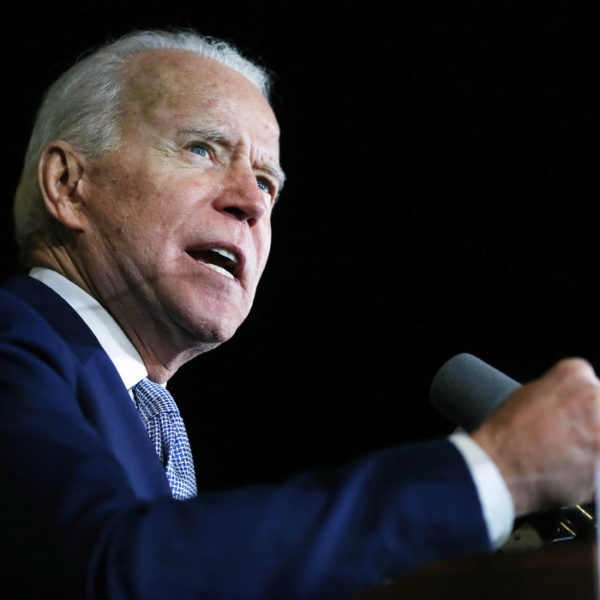Race has been a defining issue in American politics since before the country formally came into existence, a dividing line marked by generations of struggle and conflict. Today the issue is back at the center of a national debate, this time amid shifting attitudes and heightened expectations that are demanding more than sympathetic rhetoric and safe steps from political leaders.
Two unexpected events acted as the catalysts that produced this moment. The coronavirus pandemic has disproportionately killed black Americans and exposed a broader range of inequalities that persist in black communities; the recession that accompanied the pandemic has highlighted similar inequities. And the brutal killing of George Floyd by police in Minneapolis has prompted many people to acknowledge that the lives of black Americans are profoundly different than those of white Americans — and that racism is part of that lived experience.
The protests that followed the killing of Floyd have been described as an inflection point for the country. That conclusion may be premature, given how deeply embedded structural racism is in America’s history and culture and the fractured and polarized political system.
Political Reckoning
But when two in three Americans now say they support the Black Lives Matter movement; when thousands upon thousands of Americans march in the streets of big cities and small towns; when the National Football League reverses its position on players’ kneeling during the national anthem; when Mississippi eliminates the Confederate symbol from its flag; there seems little question that for now, this is a materially different moment.
What will come of the gathering call for action? The civil rights movement produced landmark legislation, but blacks continue to face discrimination in virtually all aspects of life. Economic gains for many black Americans are undeniable, yet huge disparities in jobs, housing, income and wealth still exist.
The killings of Trayvon Martin, Michael Brown and Eric Garner gave rise to the Black Lives Matter movement but did not stop the use of deadly force by police against unarmed black people. Nor did the election of the nation’s first black president result in any healing. Quite the opposite.
Under President Trump, who has used racist messaging continually as president and before, Republicans are ill-positioned to respond fully to the moment that has arisen this summer. The party is captive of his rhetoric and actions, which exacerbate rather than reduce tensions. A part of their coalition has moved in a more progressive direction on issues of race, but overall the party is on the wrong side of public opinion and stymied as to how far it can go.

Democrats are more unified and eager to show they hear the chants from the streets. But they also face more intense pressure from black Americans, who are the party’s most loyal constituency. A significant gap remains between the activist community — especially young activists — that has led the protests and pushed public opinion, and a Democratic establishment, now led by former vice president Joe Biden, that has been cautious in its commitments beyond police reform.
Across the country, institutions, corporations and other organizations are moving to implement new policies on diversity and inclusion and to eliminate as much as possible the scourge of discrimination. Forced by public opinion and the marketplace, they are removing symbols that have caused pain to black Americans for generations. Meanwhile, the political power structure in Washington has been caught up in predictable partisanship and paralysis.
Sen. Cory Booker (D-N.J.) said he is confident that strong policing legislation that has stalled in Congress will eventually pass, and that the protesters are laying the foundation for bigger changes beyond that — but only if politicians absorb the spirit of what they’re saying.
When the Black Lives Matter movement began, he noted, the reaction of establishment politicians was to run from it, to say that all lives matter. Today, the same is happening with some of the issues that are part of that movement, whether calls to defund the police or demands to address the issue of reparations.
“If we trip over the language itself [and] we can’t get to the substance, to the heart, to the truth of which they speak, then we will miss an opportunity,” Booker said. “And I think there is a tremendous opportunity here.”
This has been a time of awakening, but in the end, there is a question of whether the movement will be strong and sustained enough to produce more than small steps and symbolic gestures from Washington.
“It doesn’t take a lot, nor does it cost a lot, to protest the torture and killing of a man on video,” said Vincent Hutchings, a political scientist at the University of Michigan, adding that resolving “the original sin of racism is going to take a lot more than condemning murderous police officers.”

Race reshaped the two political parties
American politics has arrived at this moment of racial reckoning deeply polarized and with a party structure shaped profoundly by the politics of race. Ideology, religion and culture are a part of the polarization, but over the past half-century, race has been at the core of the sorting out.
The story of how the Republican Party, once the party of Abraham Lincoln, became almost entirely dependent on white voters, and how the Democratic Party, once the party of southern segregationists, became the political home to black Americans and other minorities has been years in the making.
Historian Jill Lepore has observed that at an earlier point in the country’s history, there were in essence three political parties — Republicans, Democrats and millions of black Americans denied the right to vote. Those who could vote began to move from the Republican Party to the Democratic Party during the New Deal of President Franklin D. Roosevelt.
But even as the allegiance of some black voters was shifting, the two major parties were perceived more or less equally in their capacity to address issues of race, and many black voters continued to side with the Republicans. In his reelection campaign in 1956, President Dwight D. Eisenhower received around 40 percent of the black vote.
In the spring of 1956, two years after the Supreme Court’s decision in Brown v. Board of Education, which ordered an end to school desegregation, the Gallup Poll asked Americans which of the two major parties they saw as best able to handle the issue of segregation. Twenty-eight percent said the Republican Party, 26 percent said the Democratic Party, 22 percent said both parties and 24 percent had no opinion.
By the summer of 1964, a seismic shift in perceptions of the parties was underway. That was the summer when Congress passed the Civil Rights Act. Not long after, Gallup asked Americans which party would do the best job “of handling relations between the whites and the Negroes.” Rather than a near-even split, 50 percent said the Democrats while 18 percent said Republicans.
“It starts in 1932 but ends in 1964,” said Andra Gillespie, a political science professor at Emory University. “That’s where the perceptual advantage becomes clear. It was [then-president] Lyndon Johnson’s embrace of civil rights [that] signaled that the Democratic Party was going to be more aggressive in pursuing issues of civil rights.”
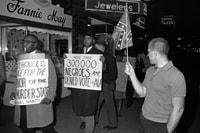
But it was more than Johnson’s advocacy of landmark civil rights legislation that reshaped perceptions and ultimately the parties’ coalitions. Sen. Barry Goldwater (R-Ariz.), who lost in a landslide to Johnson in 1964, had voted against the Civil Rights Act that year, though a majority of Republican senators supported it.
President Richard M. Nixon, elected in the tumultuous year of 1968, embraced the infamous “Southern strategy” that was designed to bring white conservatives from the South, repelled by a northern Democratic Party’s position on race, into the GOP coalition.
The racialization of politics continued over several decades as the party coalitions sorted themselves out. Many voters in the South continued to identify culturally as Democrats — identity being hard to shake — but increasingly they were voting for Republicans, beginning at the presidential level and moving down the ballot over time.
“Until the mid-1960s, Republicans were more liberal on race and conservative on economics and the Democrats the reverse,” said James Campbell, a political scientist at the University of Buffalo. “The staggered realignment from the mid-1960s to mid-1990s reconfigured the parties and the issues so that Republicans were more conservative on all issues, including racial issues, and Democrats more liberal on all issues.”
But race was always at the core of the divisions, and it soon became a weapon in political campaigns. Republicans used race issues, explicit or coded, as a wedge to splinter a Democratic Party that itself was becoming culturally more liberal. To go along with their southern recruits, Republicans began to pick up the support of more and more of the white working-class Democrats in the North — Reagan Democrats as they became known in the 1980 election.
To win back the presidency for his party, Bill Clinton sought to navigate that politically charged political minefield as a New Democrat who could appeal both to the party’s black constituency while mitigating the concerns of white working class voters.
His efforts were seen as brilliant politics and proved highly successful electorally, sweeping Clinton into the White House in 1992 and to reelection four years later, though some critics then and now see some of the policies he embraced as a candidate and president, among them the 1994 crime bill that led to mass incarcerations, as having hurt the black community.
One of the principal authors of that crime bill was then-Sen. Joe Biden, and that history continues to dog the former vice president and now presumptive Democratic presidential nominee as he seeks to energize black voters — especially those under age 40 — this November.
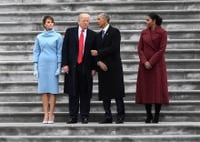
Obama’s election was a turning point
The election of Barack Obama in 2008 shattered a barrier many people thought they might not see in their lifetimes. His victory appeared to herald a new chapter in relations among the races.
Gillespie was doing political commentary that night for a local television station. “I remember that the Republican officials who were in the room that day, when it happened, said quietly that this is probably for the best,” she recalled.
That was a widespread interpretation in the days and weeks after his election but it was wrong. Instead Obama’s presidency moved polarization to another level. As the most visible face of the Democratic Party, Obama’s presidency brought even more clarity to the question of which party stood with and for black Americans and with it more division.
Obama’s election produced a backlash, one that gave rise to a tea party movement fueled by anti-government sentiment but also by racial resentment. In that same time, what also took root was a birther lie that claimed that Obama had not been born in America, a conspiracy that eventually was shared by a sizable minority of Republicans.
“A lot of people didn’t know or couldn’t place the Democrats to the left of the Republicans on racial issues or immigration issues — until Obama,” said Michael Tesler, a political science professor at the University of California Irvine. He added: “As the Obama presidency goes on, you start to see him hemorrhaging these racially conservative, lower-educated voters. . . . It was ripe for someone like Trump to pick up.”
“When we have an increasingly racially diverse Democratic Party, the priorities of the party begin to change, and that further makes clear what the party is for and it changes even more,” said Lilliana Mason, a political science professor at the University of Maryland.
Trump had long picked at the divisions over race. As a businessman, he called for the death penalty for the wrongly convicted Central Park 5 and has never apologized for doing so. In 2011, he enthusiastically embraced the birther lie until Obama shut him down by producing his birth certificate from Hawaii.
As a candidate in 2016, Trump attacked Mexican immigrants and Muslims and used illegal immigration as a wedge to stoke resentment. In office, he had a shocking reaction to the white supremacist march in Charlottesville in 2017 that resulted in violent clashes and the death of a young woman. He said there were “very fine people” on both sides.

Trump has argued that his policies have helped black Americans, from the lowering of black unemployment (until the coronavirus pandemic drove the economy into a recession) to the passage of a criminal justice reform bill. But his presidency has been marked by more racial antagonism and more public expressions of white supremacy. His party has been stamped indelibly in the eyes of black Americans — and others — by his actions.
If unexpected events this spring and summer combined to create this new moment in politics, it was not wholly accidental that it would happen. The past decade or more helped create today’s climate.
“Changes in our political structure have made it possible for Democrats to be more open [about race],” said Daniel Gillion, a political science professor at the University of Pennsylvania. “That empowers protesters to go out and ask for change. If there had not been growing polarization after Obama’s election and [the creation of] the Black Lives Matter movement, it would be harder for people to accept this.”
National attitudes about race have become more progressive over decades but in the past half dozen years, some of the most dramatic shifts have taken place among white Democrats. As the Democratic Party has shed racially conservative voters and as violence against blacks has continued, white Democrats have become more like black Democrats in their perceptions of racism, discrimination and policing.
The General Social Survey at the University of Chicago’s National Opinion Research Center has asked a series of questions about racial matters for several decades that highlight the shifts among white Democrats from the months just before Obama was elected until 2018, after he left office.
In the 2008 survey, 29 percent of white Democrats said the nation was spending “too little” on assistance for blacks. By 2018, a majority of white Democrats — 57 percent — said too little was being spent. In 2008, 37 percent of white Democrats said the nation was doing too little to improve the condition of blacks. By 2018, that view was held by 67 percent of white Democrats.
In 2008, there was a 25-point gap — 53 percent to 28 percent — between black and white Democrats on the question of whether discrimination was mainly the reason African Americans have worse jobs, income and housing than whites. By 2018, the gap was just 5 points — 67 percent to 62 percent.
A recent Washington Post/Ipsos survey showed that 95 percent of black Democrats and those who lean Democratic, along with 89 percent of white Democrats and leaners, said the country needs to continue to make changes to give blacks equal rights with whites. A majority of Republicans disagreed.
As Christopher Stout, a political scientist at Oregon State University, put it: “Wading into racial politics energizes Democrats.”
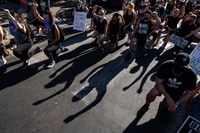
Protest politics force politicians to act
The protests have forced the country and its political leaders to react, but the coming debates are likely to be long and difficult, especially in the absence of pressure from the outside.
“What happens when whites in the protest movement go back home?,” said Eduardo Bonilla-Silva, a professor of sociology at Duke University. “Do they go back to . . . a segregated life? And secondly, and more importantly . . . what will happen once the movement collapses, once it dissipates? Will whites return to whiteness as usual, or will the changes that we see today in attitudes remain a permanent feature of their souls?”
Beyond the issue of policing and police reform, there is no agreement on a broader agenda to address structural racism and inequality. “Policing is just the focal point,” said Christopher Sebastian Parker, a political scientist at the University of Washington. “It’s a point on which we’re focusing now. But for black people, it’s much deeper than that.”
From calls to defund the police to the issue of reparations to ideas for more race-conscious policies designed to address inequities in education, health care, hiring or housing, particularly for black Americans, the possible agenda to address racial issues is expansive and challenging — and potentially still more wrenching — than the country is prepared to address.
William Darity Jr. and A. Kirsten Mullen argue the case for reparations in a book published in April — “From Here to Equality: Reparations for Black Americans in the Twenty-First Century” — and others now see the possibility for a serious examination of the issue by Congress in the near future.
“This doesn’t mean you’re going to get reparations,” said Trevon Logan, a professor of economics at Ohio State University. “But at least these are not ideas that are immediately laughed at when they’re suggested.”
Advocates of change see a bias in the public debate. Race-conscious policies designed to alleviate discriminatory policies often become political flash points and villainized. But policies that perpetuate discrimination or are racially biased — whether in policing or education or health care — are not. Would there be a different reaction to the coronavirus if whites were disproportionately affected rather than people of color?
“It’s easy to say transformative change should happen inside of an institution that doesn’t impact your life,” said Megan Ming Francis, a political science professor at the University of Washington. “So a lot of people who have never been incarcerated, never been stopped by police, say, ‘Oh my God, this is crazy.’ But what about the systemic racism in education? What about the systemic racism in housing policy? What about the systemic racism in the workplace?”
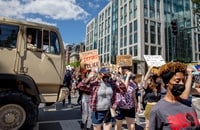
Claire Jean Kim, a political science professor at the University of California at Irvine, defines the condition as one of structural antiblackness rather than structural racism, a distinction that puts a particular spotlight on the long struggle among black Americans in particular.
“We have learned a narrative of U.S. exceptionalism, which tells us slavery was the original sin but we’ve moved toward the promised land, that time itself brings a resolution of our race problems,” she said. “It’s hard to make an intellectual adjustment to see the continuities in black subordination that have existed for centuries. People prefer to be in denial about that.”
Republican elected officials, clearly mindful of the public reaction to the Floyd killing and repelled by the video images of his death, have been scrambling to blunt criticism that their party is indifferent or even hostile to conditions faced by black Americans, advancing their own legislation to reform policing.
Overall, however, they are constrained, torn by the new politics of race that are emerging and the politics that come with an older, white constituency that is out of step with public opinion on these issues and with a history of having sought to weaponize race in political campaigns.
Democrats have fewer constraints, given that their coalition is now more closely united and the politics of race have shifted. Kevin Mumford, a political scientist at the University of Illinois, said Democrats will have to go further than they’ve been willing in the past.
“The old complaint is that the Democratic Party takes black voters for granted,” he said. “They can’t speak to black voters in one breath and white voters in another. They have to have some courage and say, ‘This is our stand.’ ”
But there are doubts that Democratic leaders are prepared to fully engage. Biden disappointed many black activists when he quickly distanced himself from calls to defund the police and advanced proposals that would increase funding by $300 million for law enforcement.
Mainstream Democrats who feared any embrace of the slogan “defund the police” would give Trump a weapon in the presidential election saw Biden’s move as politically sensible. To activists and their allies, it closed off a discussion they see as important — the allocation of resources to law enforcement versus to other social and economic policies in the black community.
“I think that there is this sense of possibility,” said Adom Getachew, a political scientist at the University of Chicago. “The question for me is whether Democrats are going to listen and take it up in any meaningful way. . . . Much of the leadership of the party seems really stuck in the ‘90s, honestly . . . and perhaps aren’t sure this will be the thing that yields political results for them.”

Young black Americans remain alienated
Another obstacle is the disenchantment among young people, particularly young black Americans, have toward traditional politics. Cathy J. Cohen, a professor of political science, oversees the GenForward survey research project that is associated with the University of Chicago and also works with the independently organized Black Youth Project.
“This is a generation that has grown up with deep political alienation,” she said. “They don’t believe leaders in government care about them. They don’t believe the Congress believes in them. . . . These young people recognize that in many ways there is systematic failure and they can’t rely on government and they have to press the issue and to do that they’re going into the street.”
In surveys she has conducted, Cohen has asked young people what they see as the best vehicle for producing progress. For young people of color, the most popular answer is organizing in communities. For young whites, it is community service and volunteer action. Federal elections fall well down the list.
Many of the cities that saw protests, some of which turned violent, have black mayors, elected leaders grappling with their own personal emotions about being black in America at the same time they were responsible for protecting their cities economic infrastructure from possible violence and destruction.
“For other generations [of young black Americans],” Cohen said, “the argument was, ‘We weren’t represented.’ But this generation has seen black elected officials . . . and lived through the election of the first black president and seen the limits.”
Trump has tried to use the protests and sporadic violence to resurrect the law and order message he advanced during his campaign in 2016 — and that Nixon used as part of his successful 1968 election.
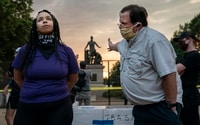
Omar Wasow, a political scientist at Princeton University, studied the connections between the violent protests that erupted after the assassination of Martin Luther King Jr. in April 1968 and the vote in November of that year. He concluded that, because of the riots, there was enough of a shift among white voters to make Nixon president.
Whether Trump can be successful with the law and order message is questionable, especially if there is minimal violence through the summer. “We’re seeing some broad, long-term trends that this isn’t just going to be a replay of ’68,” Wasow said, “because there are more people looking at what is happening and not responding with a taste for repression but with sympathy or empathy.”
Those emotions create conditions for change but the removal of Confederate monuments or the renaming of schools and institutions to eliminate vestiges of racism in the end go only so far to materially change the lives of black Americans.
Police reforms are likely, whether at the local or federal level or both, but election-year realities could stall immediate action. Anything more ambitious will await the outcome of the vote in November. By then, there will be a better sense of the staying power of the movement that has arisen.
“Politics is always going to be a part of this, and it is a blood sport,” Logan said. “But when it comes to these issues for which there now is broad consensus, what we see now is still a lack of governance . . . These things continue to persist as problems because we have not decided to actually govern and move forward and find solutions.”
The protests have been described as a cry of outrage that has resonated widely, seeming to open up opportunities that have not previously existed. But history offers sobering lessons about the ultimate power of protests. A country built for moderate change is also one that leaves frustration it its wake. Perhaps this time, the political leaders, prodded by a new generation of activists, will write a different script.


